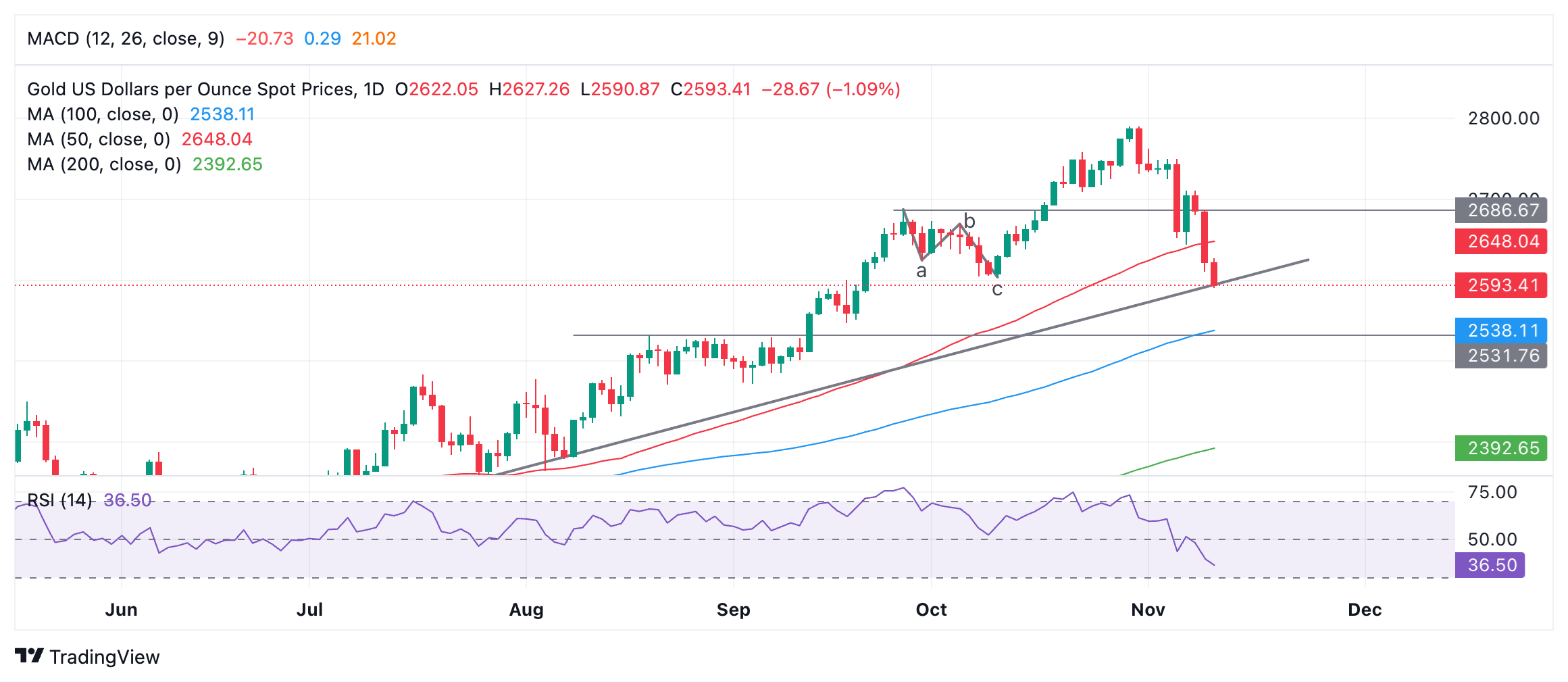- Gold falls to key support from a major trend line for the long-term uptrend at $2,600.
- A strong US Dollar is driving down the price of Gold, while competition from Bitcoin and stocks is also bearish.
- Expectations that the Federal Reserve will reduce the pace of interest rate cuts and declining safe-haven demand could also weigh on the price of Gold.
Gold (XAU/USD) is trading at seven-week lows around $2,600 as it finds support at a major trend line on Tuesday. A stronger US Dollar (USD) puts pressure on the precious metal due to market perception that President-elect Donald Trump’s economic policies will be positive for the Dollar. Since Gold is primarily priced and traded in US Dollars, a stronger USD alone is usually enough to lower its price.
Trump’s promises to impose tariffs on imports, reduce taxes and deport millions of illegal immigrants will likely raise prices in the US and drive up inflation. This would likely lead the Federal Reserve (Fed) to reduce the pace of interest rate cuts as it attempts to combat the resulting inflation. Relatively higher interest rates are negative for Gold as they increase the opportunity cost of holding the non-interest paying asset.
Market-based indicators already show a 31% chance that the Fed will keep interest rates unchanged at its December meeting, when they previously showed a 100% chance of at least a quarter-point cut, according to the CME FedWatch tool.
Gold Price Falls as Bitcoin and Stock Competition Bites
Gold is also falling due to competition from alternative assets such as Bitcoin (BTC), which continues to hit new all-time highs at $80,000 due to expectations of looser regulation of cryptocurrencies under the Trump administration.
U.S. stocks are rising as investors anticipate a corporate tax cut and looser regulations that will boost company profits.
Impact on safe haven flows
The perception that Trump will be able to end the war between Ukraine and Russia, which he boasted he could resolve “in one day – 24 hours”, could also be reducing safe haven demand for Gold.
In a private call after his election victory, Trump reportedly warned Putin “not to escalate in Ukraine,” according to The Washington Post. However, this was later denied by the Kremlin, which called such reports “pure fiction,” according to the BBC.
The war in the Middle East appears far from over as Trump strengthens ties with regional ally Israel, likely to stoke further enmity from Iran and its proxies. Latest reports suggest that Israel is stepping up its bombardment of the Gaza Strip and Lebanon with a dawn attack that killed at least 17 Palestinians in Gaza, “including 11 displaced people in the so-called al-Mawasi ‘safe zone’.” ,” according to Al Jazeera News, as well as 14 people in a northern Lebanese city far from the Israel-Lebanon border.
Technical Analysis: XAU/USD falls to support on a major trend line
Gold falls to support from a major trend line for its long-term uptrend situated around the $2,600 mark.
The precious metal has broken below the 50-day SMA at $2,648 and is now in a short-term downtrend. Since it is a principle of technical analysis that “the trend is your friend,” the odds favor a downward continuation.
XAU/USD Daily Chart
A decisive break below the main trend line would confirm an extension of the downtrend, likely to the next target at $2,538, the 100-day SMA and the August highs.
A decisive breakout would be one accompanied by a longer than normal red candle that broke well below the trend line and closed near its low, or three red candles that broke clearly below the trend line.
However, the precious metal remains in a medium to long-term uptrend, giving a material risk of an upward reversal in line with these broader cycles. Still, there are currently no signs of such a resumption as the price action remains bearish for the moment.
Gold FAQs
Gold has played a fundamental role in human history, as it has been widely used as a store of value and medium of exchange. Today, apart from its brilliance and use for jewelry, the precious metal is considered a safe-haven asset, meaning it is considered a good investment in turbulent times. Gold is also considered a hedge against inflation and currency depreciation, since it does not depend on any specific issuer or government.
Central banks are the largest holders of Gold. In their aim to support their currencies in turbulent times, central banks tend to diversify their reserves and purchase Gold to improve the perception of strength of the economy and currency. High Gold reserves can be a source of confidence for the solvency of a country. Central banks added 1,136 tons of gold worth about $70 billion to their reserves in 2022, according to data from the World Gold Council. This is the largest annual purchase since records exist. Central banks in emerging economies such as China, India and Türkiye are rapidly increasing their gold reserves.
Gold has an inverse correlation with the US Dollar and US Treasuries, which are the main reserve and safe haven assets. When the Dollar depreciates, the price of Gold tends to rise, allowing investors and central banks to diversify their assets in turbulent times. Gold is also inversely correlated with risk assets. A rally in the stock market tends to weaken the price of Gold, while sell-offs in riskier markets tend to favor the precious metal.
The price of Gold can move due to a wide range of factors. Geopolitical instability or fear of a deep recession can cause the price of Gold to rise rapidly due to its status as a safe haven asset. As a non-yielding asset, the price of Gold tends to rise when interest rates fall, while rising money prices tend to weigh down the yellow metal. Still, most of the moves depend on how the US Dollar (USD) performs, as the asset is traded in dollars (XAU/USD). A strong Dollar tends to keep the price of Gold in check, while a weaker Dollar is likely to push up Gold prices.
Source: Fx Street
I am Joshua Winder, a senior-level journalist and editor at World Stock Market. I specialize in covering news related to the stock market and economic trends. With more than 8 years of experience in this field, I have become an expert in financial reporting.








